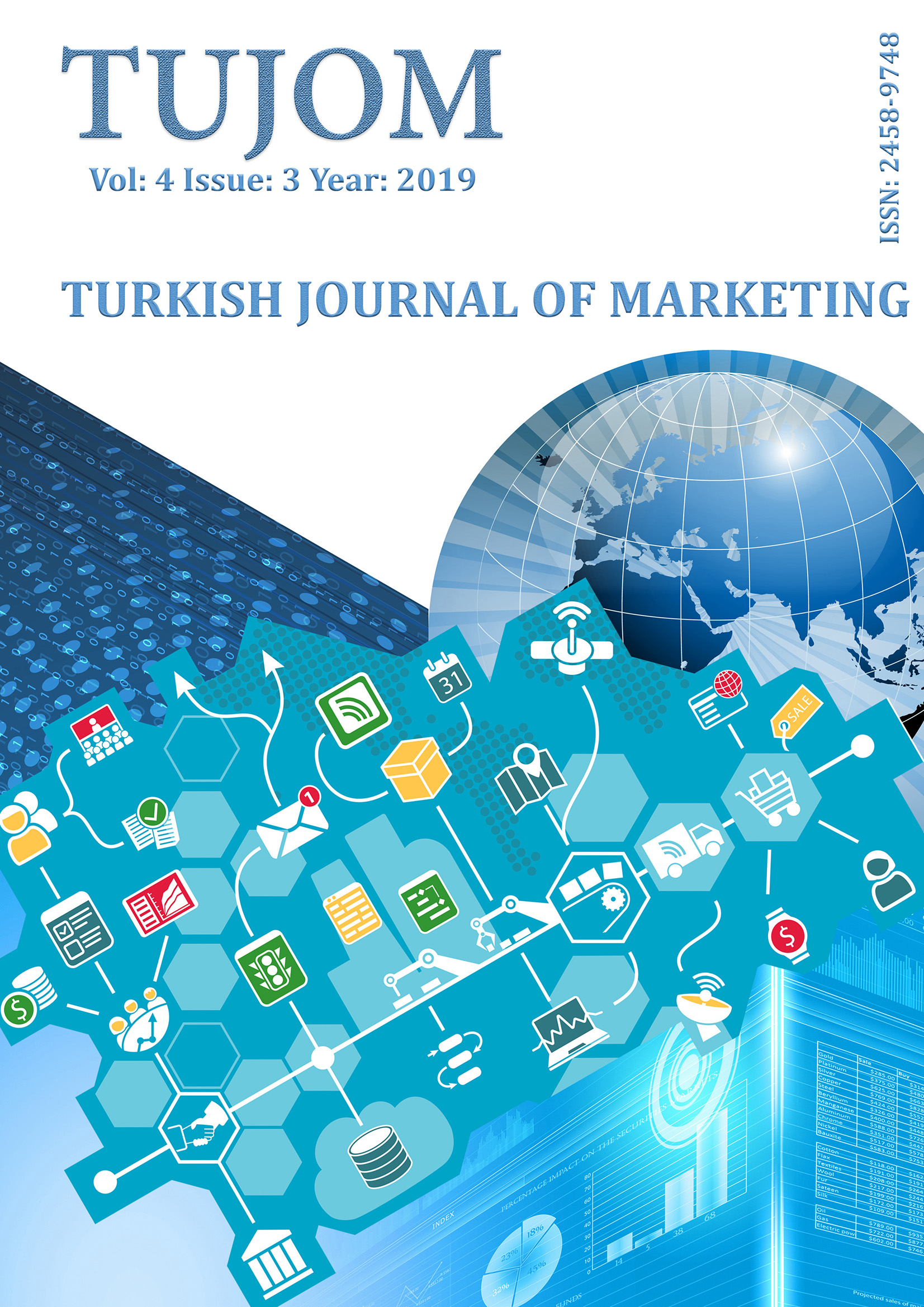DEMYSTIFYING MUSICAL PREFERENCES AT TURKISH MUSIC MARKET THROUGH AUDIO FEATURES OF SPOTIFY CHARTS
Published 12/25/2019
Keywords
- Müzik Pazarlaması, Tüketici Tercihleri, Spotify
- music marketing,
- consumer preferences,
- spotify
How to Cite
Abstract
Online music streaming services are one of the important actors in music consumption for today?s consumers. In addition to widespread use of mobile devices, many changes in the patterns of music consumption are witnessed such as the purchase of single tracks instead of albums, listening to music on different platforms, and personalized music consumption options. This study aims to examine the concept of music consumption in Turkey through audio characteristics of popular songs. Top 200 popular song-lists for 6 months period are chosen as sample and audio characteristics provided by Spotify API service regarding 676 unique songs are analyzed. Following descriptive statistics of Turkey Music Market, clustering methodology is employed and three different clusters for songs are concluded. Finally, decision tree methodology is employed to classify the dataset with popularity scores and audio characteristics together, while loudness and energy characteristics are found as significant classifiers.
Downloads
References
- Bache, S.M. & Wickham, H. (2014). magrittr: A Forward-Pipe Operator for R. R package version 1.5. https://CRAN.R-project.org/package=magrittr
- Bartmanski, D., & Woodward, I. (2015). The vinyl: The analogue medium in the age of digital reproduction. Journal of consumer culture, 15(1), 3-27.
- Borja, K., Dieringer, S., & Daw, J. (2015). The effect of music streaming services on music piracy among college students. Computers in Human Behavior, 45, 69-76.
- Bruner, G. C. (1990). Music, mood, and marketing. Journal of marketing, 54(4), 94-104.
- Chang, W. (2019). Multiple graphs on one page (ggplot2). Retrieved from http://www.cookbook-r.com/Graphs/Multiple_graphs_on_one_page_(ggplot2)/
- Cockrill, A., Sullivan, M., & Norbury, H. L. (2011). Music consumption: Lifestyle choice or addiction. Journal of Retailing and Consumer Services, 18(2), 160-166.
- Cooke, D. (1962). The Language of Music, London:Oxford University Press.
- Delsing, M. J., Ter Bogt, T. F., Engels, R. C., & Meeus, W. H. (2008). Adolescents' music preferences and personality characteristics. European Journal of Personality: Published for the European Association of Personality Psychology, 22(2), 109-130.
- Dragulescu, A.A., & Arendt, C. (2018). xlsx: Read, Write, Format Excel 2007 and Excel 97/2000/XP/2003 Files. R package version 0.6.1. https://CRAN.R-project.org/package=xlsx
- Friedl, M. A., & Brodley, C. E. (1997). Decision tree classification of land cover from remotely sensed data. Remote sensing of environment, 61(3), 399-409.
- Greenberg, D. M., Kosinski, M., Stillwell, D. J., Monteiro, B. L., Levitin, D. J., & Rentfrow, P. J. (2016). The song is you: Preferences for musical attribute dimensions reflect personality. Social Psychological and Personality Science, 7(6), 597-605.
- Henry, L., & Wickham, H. (2019). purrr: Functional Programming Tools. R package version 0.3.2. https://CRAN.R-project.org/package=purrr
- IFPI. (2019). IFPI Global Music Report 2019. Retrieved from https://ifpi.org/news/IFPI-GLOBAL-MUSIC-REPORT-2019
- Larsen, G., Lawson, R., & Todd, S. (2010). The symbolic consumption of music. Journal of Marketing Management, 26(7-8), 671-685.
- Magaudda, P. (2011). When materiality ?bites back?: Digital music consumption practices in the age of dematerialization. Journal of Consumer Culture, 11(1), 15-36.
- Mierswa, I., Wurst, M., Klinkenberg, R., Scholz, M., & Euler, T. (2006, August). Yale: Rapid prototyping for complex data mining tasks. In Proceedings of the 12th ACM SIGKDD international conference on Knowledge discovery and data mining (pp. 935-940). ACM.
- Milborrow, S. (2019). rpart.plot: Plot 'rpart' Models: An Enhanced Version of 'plot.rpart'. R package version 3.0.7. https://CRAN.R-project.org/package=rpart.plot
- Müller, K. & Wickham, H. (2019). tibble: Simple Data Frames. R package version 2.1.3. https://CRAN.R-project.org/package=tibble
- Oklap, C. (2018). Top Songs on Spotify: What makes them popular?. Retrieved from https://www.kaggle.com/cihanoklap/top-songs-on-spotify-what-makes-them-popular
- Pelleg, D., & Moore, A. W. (2000, June). X-means: Extending k-means with efficient estimation of the number of clusters. In Icml (Vol. 1, pp. 727-734).
- R Core Team (2018). R: A language and environment for statistical computing. R Foundation for Statistical Computing, Vienna, Austria. URL https://www.R-project.org/.
- RStudio Team (2015). RStudio: Integrated Development for R. RStudio, Inc., Boston, MA URL http://www.rstudio.com/.
- Rentfrow, P. J., & Gosling, S. D. (2003). The do re mi's of everyday life: the structure and personality correlates of music preferences. Journal of personality and social psychology, 84(6), 1236.
- Spotify (2019, April 29). Spotify Reports First Quarter 2019 Earnings. Retrieved from https://newsroom.spotify.com/2019-04-29/spotify-reports-first-quarter-2019-earnings/
- Spotify (2019b). Company Info. Retrieved from https://newsroom.spotify.com/company-info/
- Spotify (2019c). Get Audio Features for a Track. Retrieved from https://developer.spotify.com/documentation/web-api/reference/tracks/get-audio-features/
- Spotify (2019d). Features - Spotify for Developers. Retrieved from https://developer.spotify.com/discover/
- Spotify (2019e). Get a Track - Spotify for Developers. Retrieved from https://developer.spotify.com/documentation/web-api/reference/tracks/get-track/
- Therneau, T., & Atkinson, B. (2019). rpart: Recursive Partitioning and Regression Trees. R package version 4.1-15. https://CRAN.R-project.org/package=rpart
- Thompson, C., Parry, J., Phipps, D. & Wolff, T. (2019). spotifyr: R Wrapper for the 'Spotify' Web API. R package version 2.1.1. https://CRAN.R-project.org/package=spotifyr
- Wei, T & Simko, V. (2017). R package "corrplot": Visualization of a Correlation Matrix (Version 0.84). Available from https://github.com/taiyun/corrplot
- Weijters, B., Goedertier, F., & Verstreken, S. (2014). Online music consumption in today?s technological context: Putting the influence of ethics in perspective. Journal of Business Ethics, 124(4), 537-550.
- Wickham, H. (2016). ggplot2: elegant graphics for data analysis. Springer.
- Wickham, H. (2019). rvest: Easily Harvest (Scrape) Web Pages. R package version 0.3.3. https://CRAN.R-project.org/package=rvest
- Wickham, H., François, R., Henry, L., & Müller, K. (2019). dplyr: A Grammar of Data Manipulation. R package version 0.8.0.1. https://CRAN.R-project.org/package=dplyr
- Wlömert, N., & Papies, D. (2016). On-demand streaming services and music industry revenues?Insights from Spotify's market entry. International Journal of Research in Marketing, 33(2), 314-327.
- Zettl, H. (1973). Sight, Sound, Motion; Applied Media Aesthetics. Belmont, CA: Wadsworth Publishing Co., Inc.



